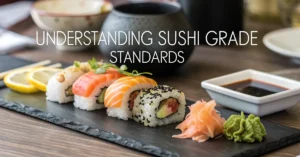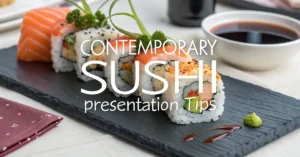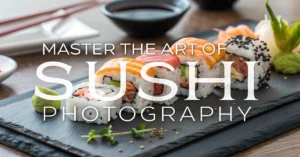The world of sushi is ever-evolving, a testament to culinary creativity and the desire to push boundaries. Forget the traditional image of neatly arranged nigiri; today, we’re diving into the vibrant and exciting realm of fusion sushi. It’s a place where cultures collide, flavors explode, and sushi becomes more than just raw fish and rice.
This isn’t about disrespecting tradition. Instead, it’s about honoring it by building upon it, adapting it, and making it relevant for a new generation of food lovers. Think of it as sushi’s adventurous cousin, the one who’s always trying new things and isn’t afraid to break a few rules.
Ready to explore the dynamic trends shaping the modern fusion sushi scene? Let’s get started.
What is Fusion Sushi?
Simply put, fusion sushi is a culinary style that blends traditional Japanese sushi techniques and ingredients with elements from other cuisines around the world. It’s a celebration of diverse flavors and innovative pairings, resulting in unexpected and delightful culinary experiences. It’s a realm where sushi chefs become artists, using their knowledge of sushi preparation as a foundation for bold and imaginative creations.
But there’s more to it than simply throwing disparate flavors together. The best fusion sushi honors the essence of sushi—fresh ingredients, balanced flavors, and skillful preparation—while incorporating outside influences in a way that enhances, rather than overpowers, the original concept. It’s about finding harmony between different culinary traditions, creating something that’s both familiar and surprising.
The History of Fusion Sushi: A Culinary Evolution
The seeds of fusion sushi were sown long ago, as Japanese cuisine began its journey of globalization. But its true emergence as a distinct culinary movement can be traced back to the late 20th century, particularly in North America.
Several factors contributed to this rise:
- Increased awareness of global cuisines: As travel became more accessible and diverse immigrant communities thrived, people became more open to trying new flavors and culinary styles.
- Experimentation among chefs: Creative chefs, looking to push the boundaries of traditional sushi, began incorporating ingredients and techniques from other cultures.
- Demand for unique dining experiences: Diners sought out restaurants that offered something different, something exciting, and something that reflected the changing culinary landscape.
One notable example is the California roll, often credited as one of the earliest examples of fusion sushi. Created in Los Angeles in the 1960s or 70s, it features avocado, crab (or imitation crab), and cucumber, rolled inside out with rice on the outside. This seemingly simple innovation was revolutionary at the time, making sushi more approachable to a Western audience.
The California roll showed that sushi could be adapted and reinterpreted without losing its core appeal. It paved the way for further experimentation and helped popularize sushi beyond traditional Japanese circles.
Why is Fusion Sushi So Popular?
Fusion sushi’s popularity stems from several key factors:
- Accessibility: For those who might be hesitant to try traditional sushi, with its emphasis on raw fish, fusion sushi offers a more approachable entry point. Cooked ingredients, familiar flavors, and creative presentations make it less intimidating and more appealing to a wider range of palates.
- Innovation: The constant experimentation and creative ingredient combinations keep fusion sushi exciting and fresh. Diners are always looking for new and unique culinary experiences, and fusion sushi consistently delivers.
- Customization: Fusion sushi allows for a high degree of customization, catering to individual preferences and dietary restrictions. Chefs can adapt recipes to accommodate allergies, vegetarian diets, and other specific needs.
- Instagrammability: Let’s be honest, a big part of dining out today is about sharing the experience on social media. Fusion sushi, with its vibrant colors, artistic plating, and unexpected ingredients, is highly photogenic and perfect for Instagram.
Key Ingredients & Techniques in Fusion Sushi
While anything is possible in the world of fusion sushi, certain ingredients and techniques frequently appear, lending themselves well to the creative process.
Common Ingredient Combinations
- Latin American Influences: Expect to see ingredients like avocado, cilantro, jalapeño, mango, and plantains incorporated into rolls and nigiri. Spicy sauces, inspired by Mexican and Peruvian cuisine, are also common.
- Mediterranean Flavors: Sun-dried tomatoes, feta cheese, olives, and artichoke hearts can add a unique twist to sushi. Olive oil and balsamic vinegar may be used in place of traditional soy sauce.
- Southeast Asian Inspiration: Think coconut milk, lemongrass, ginger, chili peppers, and peanut sauce. These ingredients bring a fragrant and spicy element to fusion sushi.
- Italian Fusion: Pesto, mozzarella, prosciutto, and basil can find their way into fusion sushi creations. Imagine a roll with seared tuna, pesto, and a balsamic glaze.
- Indian Aromatics: Curry powder, turmeric, coriander, and garam masala infuse sushi with warm and earthy flavors. Tandoori chicken or paneer can be used as fillings.
Popular Techniques
- Tempura: While tempura is a traditional Japanese technique, it’s often used in fusion sushi to add a crispy texture and cooked element. Tempura shrimp, vegetables, or even entire rolls can be found.
- Torching: Using a culinary torch to lightly sear or caramelize ingredients is a common technique in fusion sushi. It adds a smoky flavor and visual appeal.
- Sauce Innovation: Fusion sushi often features creative sauces that go beyond the traditional soy sauce and wasabi. These might include spicy mayo, eel sauce, teriyaki sauce, or even fruit-based sauces.
- Unusual Rice Preparations: Some fusion sushi chefs experiment with different types of rice or add flavors to the rice itself. Coconut rice, saffron rice, or rice mixed with herbs and spices are all possibilities.
- Creative Plating: Presentation is key in fusion sushi. Chefs often use elaborate plating techniques, incorporating edible flowers, colorful sauces, and artistic arrangements to create visually stunning dishes.
Modern Fusion Sushi Trends Explained
Let’s delve into some of the most exciting and innovative fusion sushi trends that are currently captivating diners:
1. Sushi Burritos: The Portable Powerhouse
Imagine a sushi roll, but supersized and shaped like a burrito. That’s the sushi burrito in a nutshell. This trend takes all the familiar ingredients of sushi—rice, seaweed, fish, vegetables, and sauces—and wraps them in a large nori sheet, creating a portable and satisfying meal.
Why it’s trending:
- Convenience: Sushi burritos are easy to eat on the go, making them a perfect option for busy individuals.
- Customization: The large size allows for a wider variety of ingredients and flavor combinations.
- Value for money: Sushi burritos often offer a more substantial meal than traditional sushi rolls, providing a better value for the price.
Common fillings:
- Grilled chicken or steak
- Tempura shrimp
- Pulled pork
- Avocado
- Spicy tuna
- Lettuce
- Carrots
- Cucumbers
- Spicy mayo
- Eel sauce
2. Nigiri Reinvented: Beyond the Slice
Nigiri, traditionally a simple combination of vinegared rice and a slice of raw fish, is getting a fusion makeover. Chefs are experimenting with different toppings, sauces, and even the rice itself to create nigiri that are bursting with flavor and texture.
What’s new:
- Non-traditional fish: Expect to see nigiri topped with seared scallops, grilled octopus, or even smoked salmon.
- Creative sauces: Instead of just soy sauce and wasabi, nigiri might be drizzled with truffle oil, balsamic glaze, or spicy miso sauce.
- Unique toppings: Chefs are adding unexpected toppings like crispy onions, pickled ginger, or even edible flowers to nigiri for added flavor and visual appeal.
- Flavored rice: The rice itself is becoming a canvas for experimentation, with chefs adding ingredients like yuzu zest, black garlic, or even beet juice to create unique flavor profiles and colors.
3. Plant-Based Fusion: Sushi for Everyone
As plant-based diets become increasingly popular, fusion sushi is adapting to meet the demand for vegetarian and vegan options. Chefs are using creative plant-based ingredients to mimic the flavors and textures of traditional sushi, creating delicious and satisfying options for everyone.
Plant-based stars:
- Avocado: A classic vegetarian sushi ingredient, avocado provides a creamy texture and healthy fats.
- Tofu: Marinated or fried tofu can be used as a substitute for fish, adding protein and a savory flavor.
- Eggplant: Grilled or roasted eggplant can be used to create a smoky and meaty flavor.
- Mushrooms: Portobello, shiitake, and other mushrooms can be marinated and grilled to add a umami flavor.
- Jackfruit: This versatile fruit can be shredded and seasoned to mimic the texture and flavor of pulled pork or tuna.
- Vegetable Purees: Beetroot, carrot, or sweet potato purees can be used to add vibrant color and subtle sweetness to sushi rice and sauces.
4. Deconstructed Sushi: The Art of Assembly
Deconstructed sushi takes all the elements of a traditional sushi roll—rice, fish, vegetables, and sauces—and presents them separately, allowing diners to assemble their own creations. This trend emphasizes the quality of the individual ingredients and allows for a more interactive dining experience.
Why deconstruct?
- Ingredient focus: Deconstruction highlights the freshness and quality of each ingredient.
- Customization: Diners can create their own flavor combinations and adjust the proportions to their liking.
- Interactive dining: Assembling your own sushi adds an element of fun and engagement to the meal.
- Aesthetic Appeal: Deconstructed sushi platters, with their colorful ingredients and artistic arrangements, are visually stunning.
5. Sweet Sushi: Dessert Takes Center Stage
Who says sushi can’t be dessert? This trend takes the basic principles of sushi and applies them to sweet ingredients, creating visually appealing and surprisingly delicious desserts.
Sweet ingredients:
- Sweet rice: Rice cooked with coconut milk, sugar, or other sweeteners forms the base of sweet sushi.
- Fruit: Mango, strawberries, kiwi, and other fruits add sweetness and vibrant color.
- Chocolate: Chocolate shavings, ganache, or even chocolate-covered rice can be used to create decadent desserts.
- Sweet sauces: Caramel sauce, chocolate sauce, or fruit-based sauces drizzle over sweet sushi creations.
- Crepes or Thin Pancakes: These can be used in place of nori to wrap sweet fillings.
Example creations:
- Mango sticky rice sushi: Sweet rice topped with fresh mango and drizzled with coconut milk.
- Chocolate banana sushi: Sweet rice wrapped in a crepe with banana and chocolate sauce.
- Strawberry cheesecake sushi: Sweet rice topped with cream cheese, strawberries, and graham cracker crumbs.
6. Global Ingredient Mashups: No Flavor Unturned
This trend represents the purest form of fusion sushi, bringing together ingredients and techniques from all corners of the globe to create truly unique and unexpected flavor combinations. The possibilities are endless, and the only limit is the chef’s imagination.
Examples:
- Indian-inspired sushi: Sushi rice flavored with curry powder, topped with tandoori chicken and a mint-cilantro chutney.
- Mexican-inspired sushi: Sushi rice mixed with cilantro and lime, topped with grilled shrimp, avocado, and a spicy chipotle sauce.
- Mediterranean-inspired sushi: Sushi rice mixed with sun-dried tomatoes and olives, topped with feta cheese, cucumber, and a balsamic glaze.
- Korean-inspired sushi: Sushi rice mixed with kimchi, topped with bulgogi beef, sesame seeds, and a gochujang mayo.
7. Local and Sustainable Focus: From Ocean to Table
As consumers become more conscious of the environmental impact of their food choices, fusion sushi is embracing local and sustainable ingredients. This means sourcing fish from local fisheries, using organic vegetables, and minimizing waste.
Sustainability in action:
- Locally sourced fish: Chefs are partnering with local fishermen to source fresh, sustainable seafood.
- Sustainable seafood certifications: Restaurants are seeking out certifications like the Marine Stewardship Council (MSC) to ensure that their seafood is sourced responsibly.
- Reducing food waste: Restaurants are implementing strategies to minimize food waste, such as using scraps to make sauces or compost.
- Promoting underutilized species: Chefs are showcasing lesser-known species of fish to reduce pressure on overfished populations.
8. Experiential Dining: More than Just a Meal
Fusion sushi is no longer just about the food; it’s about the entire dining experience. Restaurants are creating immersive and engaging environments that enhance the enjoyment of the meal.
Experiential elements:
- Interactive sushi bars: Diners can sit at a sushi bar and watch the chefs prepare their food, learning about the ingredients and techniques.
- Omakase menus: Chefs create a personalized tasting menu based on the diner’s preferences and the freshest available ingredients.
- Themed dining rooms: Restaurants are designing their spaces to reflect the fusion theme, creating a unique and immersive atmosphere.
- Sushi-making classes: Diners can learn how to make their own fusion sushi at home.
9. Tech-Enhanced Sushi: The Future is Now
Technology is playing an increasing role in the fusion sushi experience, from ordering and payment to preparation and presentation.
Tech integrations:
- Online ordering and delivery: Apps and websites make it easy to order fusion sushi for takeout or delivery.
- Tablet menus: Diners can browse menus and place orders on tablets, with detailed descriptions and photos of each dish.
- Robotic sushi chefs: Some restaurants are using robots to automate the preparation of sushi rice and other tasks.
- Projection mapping: Restaurants are using projection mapping to create interactive and visually stunning displays on the sushi bar or tables.
10. Hyper-Personalization: Sushi Just for You
The ultimate fusion sushi trend is hyper-personalization, where diners can create their own custom sushi rolls and nigiri, tailored to their exact preferences. This trend empowers diners to experiment with different flavors and ingredients, creating a truly unique culinary experience.
Customization options:
- Ingredient selection: Diners can choose from a wide variety of fish, vegetables, sauces, and toppings to create their own signature sushi.
- Portion control: Diners can specify the size of their sushi rolls and nigiri.
- Dietary restrictions: Diners can easily accommodate allergies, vegetarian diets, and other dietary restrictions.
- Interactive ordering systems: Restaurants are using interactive ordering systems to guide diners through the customization process, providing suggestions and inspiration.
The Future of Fusion Sushi: What’s Next?
The fusion sushi scene shows no sign of slowing down. As global culinary influences continue to blend and technology advances, we can expect to see even more innovative and exciting trends emerge.
Here are a few predictions for the future:
- Increased use of AI: Artificial intelligence will be used to analyze flavor combinations, predict customer preferences, and even design new fusion sushi creations.
- More emphasis on sustainability: Sustainable seafood and plant-based ingredients will become even more prominent in fusion sushi.
- Virtual reality dining experiences: Diners will be able to immerse themselves in virtual reality environments that enhance the enjoyment of their fusion sushi meal.
- DIY fusion sushi kits: Consumers will be able to purchase kits that contain everything they need to make their own fusion sushi at home.
Is Fusion Sushi “Real” Sushi?
This question often sparks debate among sushi purists and fusion sushi enthusiasts. The answer, of course, depends on your perspective.
From a traditional standpoint, fusion sushi may be seen as a deviation from the authentic art of sushi preparation. Purists argue that it compromises the integrity of the ingredients and the delicate balance of flavors that characterize traditional sushi.
However, from a more progressive viewpoint, fusion sushi can be seen as a natural evolution of Japanese cuisine, reflecting the changing tastes and preferences of a global audience. Proponents argue that it expands the possibilities of sushi, making it more accessible and appealing to a wider range of people.
Ultimately, whether or not fusion sushi is “real” sushi is a matter of opinion. Both traditional and fusion styles have their own merits and appeal to different audiences.
How to Find the Best Fusion Sushi Restaurants
With the rising popularity of fusion sushi, it can be tough to know where to start. Here are some tips for finding the best fusion sushi restaurants:
- Read online reviews: Check out online reviews on websites like Yelp, Google Reviews, and TripAdvisor to get an idea of the restaurant’s quality and reputation.
- Ask for recommendations: Ask friends, family, or colleagues for their recommendations.
- Look for creativity and innovation: The best fusion sushi restaurants are constantly experimenting with new flavors and ingredients.
- Consider the atmosphere: Choose a restaurant that has a comfortable and inviting atmosphere.
- Check out the menu online: Before visiting a restaurant, browse their menu online to see if they offer the types of fusion sushi that appeal to you.
Trying Fusion Sushi at Home: A Beginner’s Guide
Intrigued by fusion sushi but not ready to dine out? No problem! You can easily experiment with fusion sushi at home. Here are some tips to get you started:
- Start with the basics: Master the art of making sushi rice and rolling sushi rolls.
- Experiment with different ingredients: Try adding different vegetables, sauces, and toppings to your sushi rolls.
- Don’t be afraid to be creative: There are no rules when it comes to fusion sushi, so let your imagination run wild.
- Use high-quality ingredients: The quality of your ingredients will have a big impact on the taste of your fusion sushi.
- Have fun! Making fusion sushi should be a fun and enjoyable experience.
From California Rolls to Culinary Masterpieces: A World of Flavor Awaits
Fusion sushi represents a dynamic and exciting evolution of a beloved culinary tradition. By embracing global flavors, innovative techniques, and a spirit of experimentation, fusion sushi continues to captivate diners and push the boundaries of what sushi can be.
Whether you’re a seasoned sushi aficionado or a curious newcomer, exploring the world of fusion sushi offers a delicious and rewarding culinary adventure. So, go ahead, be bold, and discover your new favorite roll!



